A Day Inside Myanmar’s Unremarkable Parliament
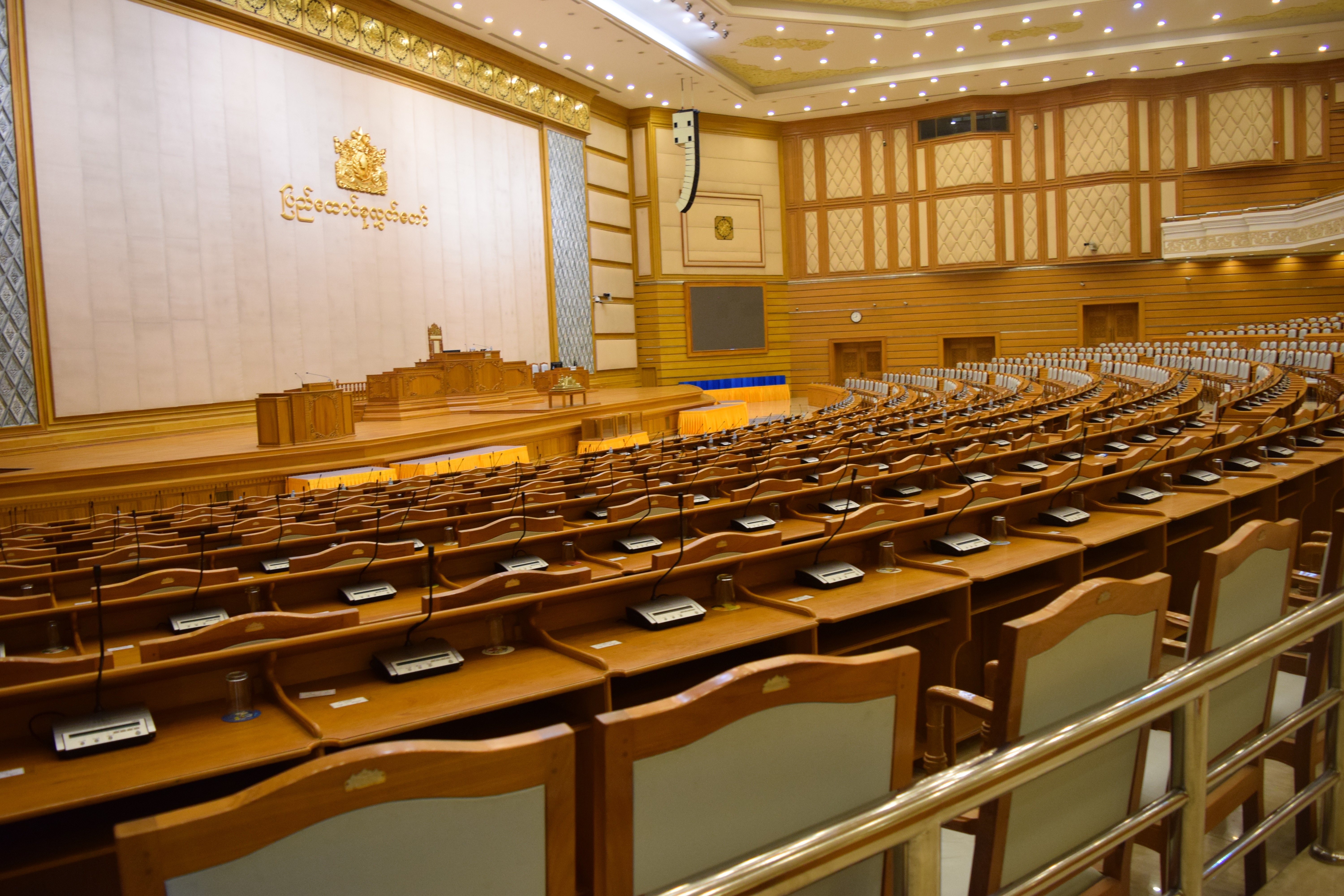
55 years ago, the world watched as Myanmar, formerly Burma, suffered a revolutionary coup d’état in which the country’s military toppled the civilian, pro-independence Anti-Fascist People’s Freedom League-government (AFPFL). The military remained in power until 2015 when open, multi-party elections were finally permitted and the National League for Democracy (NLD) won a landslide victory. 44 years after the coup, in 2006, while the military was still in power, the government announced that the country’s capital would be moved from the cosmopolitan, southern city of Yangon, to the desolate, ghost town of Naypyidaw, nearer to the country’s centre. In addition to the relocation, the military commissioned the construction of an expansive parliamentary complex in which parliament, referred to as the Pyidaungsu Hluttaw, or simply, Hluttaw, in Myanmar, would assemble, as well as the construction of hotels and wannabe tourist attractions, such as the Uppatasanti Pagoda, a replication of the famous Shwedagon Pagoda in Yangon. Many have dubbed the relocation and mass construction as a mere “vanity project” of former military leader Than Shwe, in an attempt to show off the country’s riches and military might, while others criticized the blatant frivolity as an affront to the millions of Myanmar citizens who were living in poverty at the time, many of whom still are.
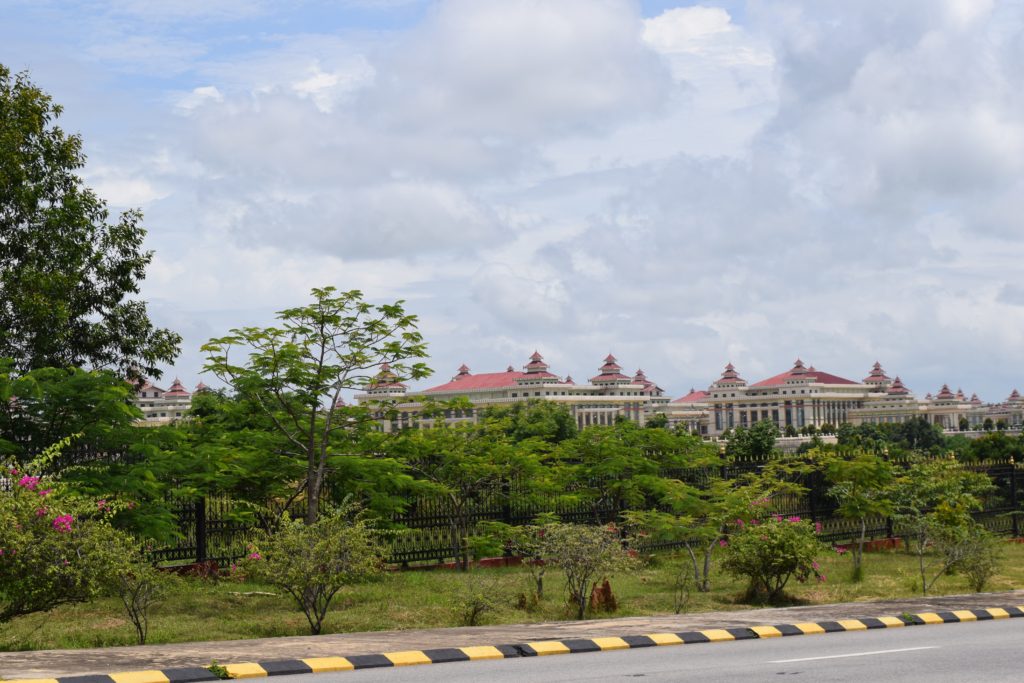
This past summer I had the opportunity to travel to Myanmar and visit the Hluttaw. I had read that tourists could visit the Hluttaw, free of charge, so long as they applied for a permit through the Ministry of Hotels and Tourism. I contacted the Ministry and sent them an email outlining my citizenship, visa status, purpose of visit, and so forth. The Ministry explained that they would submit my information to a Hluttaw official, and if approved we could then apply for a formal permit, which would include both entry into the Hluttaw buildings, as well as an invitation to attend one of the two three-hour daily parliamentary meetings.
After a couple of weeks our preliminary applications were finally approved, but to obtain the formal permit we would need confirmation of a hired car and driver that could take us to and from the Hluttaw, which proved to be very difficult to arrange. Given the tiny population of Naypyidaw and the even smaller number of tourists it seems to attract, it was unsurprising to learn that there were no car rental companies anywhere in or near the city. After hours of scrolling through commentary on various tourism websites, we finally came across the name and number of a freelance driver who agreed to drive us. Later we learned that he had never visited the Hluttaw before and it was as much an opportunity for him as it was for us, if not more so.
At 8:15am on June 29th, our driver, along with our Hluttaw liaison, a Ministry staff who was to accompany us on our visit, arrived at our hotel to pick us up. We drove down the empty streets and watched as the desolate, capital city slowly began to wake up. We eventually turned onto the somewhat famed and quite surreal 20-lane highway that was built to serve as a metaphorical wall around the Hluttaw. The highway is one of the few celebrated tourist attractions in Naypyidaw, as the small number of foreigners that frequent the city apparently enjoy sitting (or laying) in the middle of the road and having their picture taken, so our guide told us. Our guide also informed us that the highway was wide enough for a small airplane to land, and although no plane had ever done so, many believed that it had been built with this in mind. This endeavour seemed like yet another attempt for the military to show-off their wealth and power in a largely profligate way.
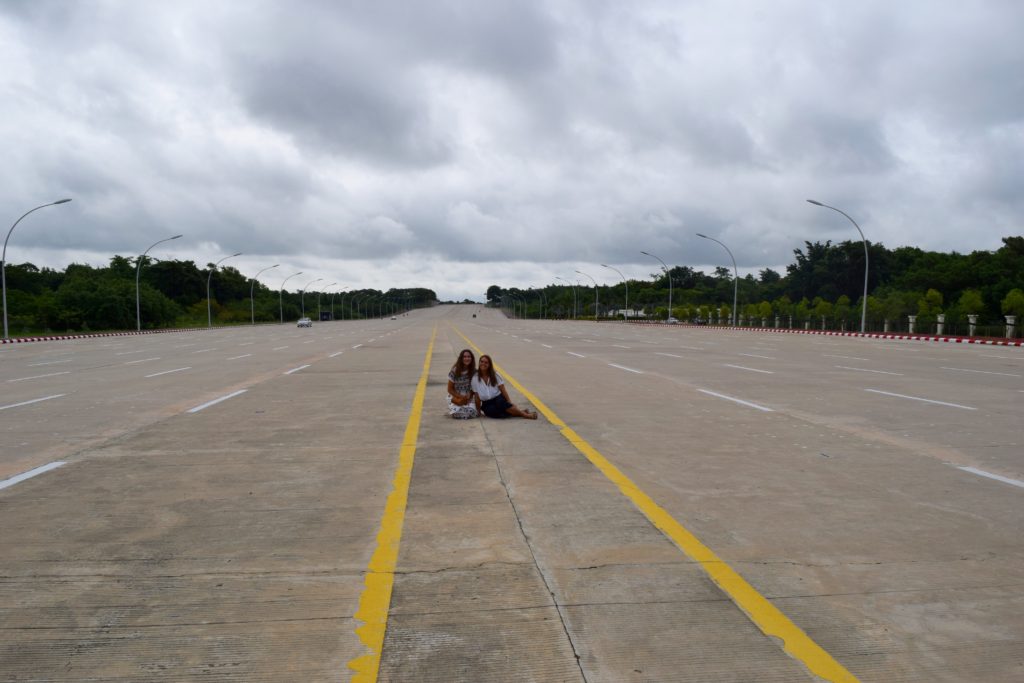
We finally pulled up to the rather grand, palace-like gates of the Hluttaw. Just outside of the gates, our guide got out of the car and walked up to the security booth to get our passes. A guard then came up to the car to look inside and verify the number of people in the vehicle. Once we were cleared, the guard signalled to his counterparts in the booth and the giant, black metal gates slowly began to open.
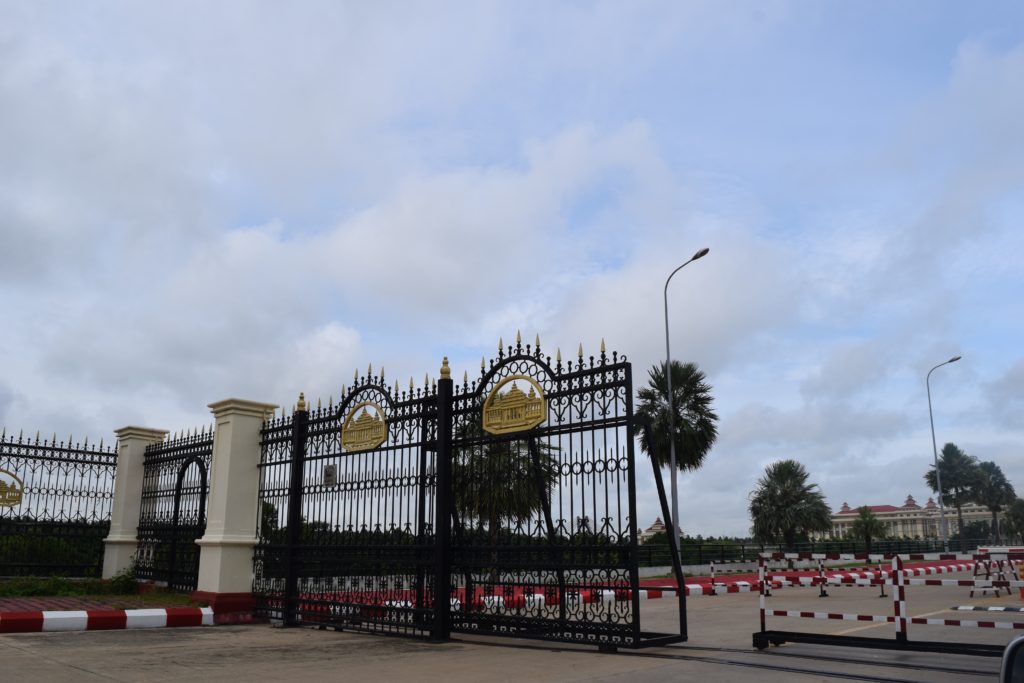
The first and, arguably most, striking feature of the complex is its size. Although I knew that the grounds consisted of 31 buildings, considering the poverty and turmoil that had plagued Myanmar for the last half-century, I was expecting something somewhat modest in scale, but, instead, the complex appeared larger than life. We drove over the bridge, separating the Hluttaw from the outside world, and up the long driveway towards the first cluster of buildings, which house the assembly meeting halls and several large conference rooms. The Hluttaw is a national-level bicameral legislative body, consisting of a 224-seat upper house, the House of Nationalities, the Amyotha Hluttaw, and a 440-seat lower house, the House of Representatives, the Pyithu Hluttaw. In both houses, all sitting representatives are referred to as Members of Parliament (MPs), and 75% of the MPs are democratically elected while the other 25% are appointed, as per the constitution, by the military. During our visit, we would be sitting in on a meeting in the lower house, the Pyithu Hluttaw.
We were dropped off at the visitor’s entrance, a lavish ballroom with intricately-carved jade columns and a huge golden replica of the traditional Myanmar rice bowl. From the lobby, we were escorted through the building to the main entrance where we could wait and watch the MPs arrive. In addition to our guide, two young female parliament employees had joined us on our visit. While we were waiting, we had the chance to speak with them about their experiences at the Hluttaw and ask them about their views on their country’s complex government. One of the girls explained that, from her experience, the democratically-elected MPs and the military MPs both not only “know the needs of society”, but are also able to “cooperate very well” in developing multilateral solutions to address these needs. Although she did not expand very much on this point of possible bipartisanship, she seemed to imply that this “cooperation” not only took place behind closed doors, but involved trade-offs between the various political parties.
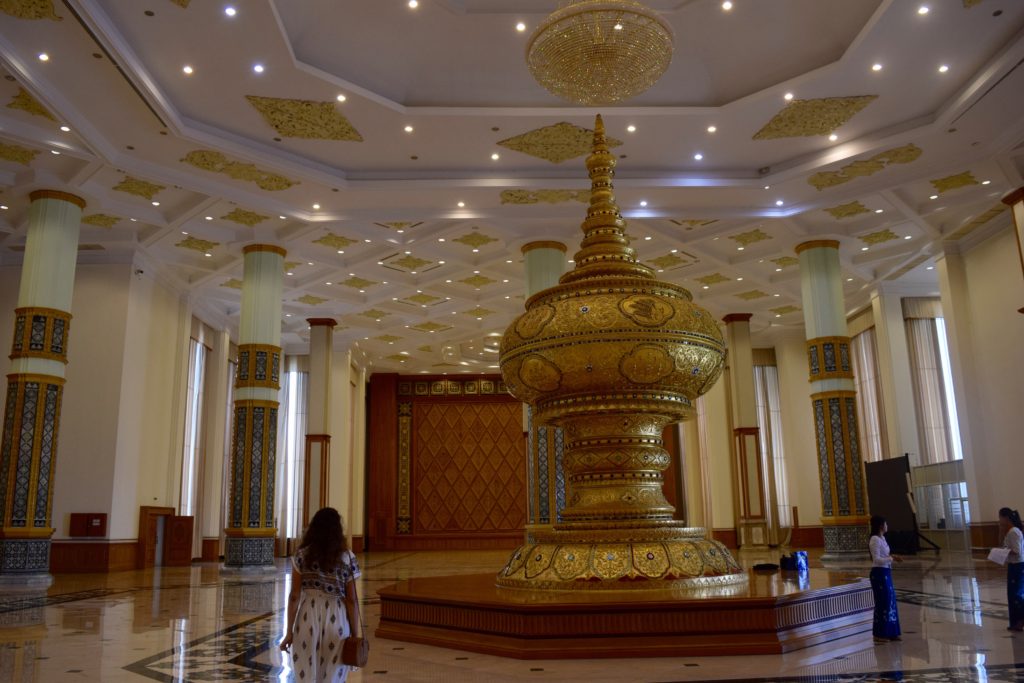
We took some pictures in front of the entranceway and then waited outside for the MPs to arrive. Due to the general poverty and lack of housing in Naypyidaw, the MPs are assigned to shared “military style dorms” while parliament is in session, that cost approximately 2000 kyatts (about 2 CAD) a day and have been likened to barracks and jail cells. Interestingly, the dire living conditions are reportedly consistent among all MPs from all political parties, including the military MPs, which is somewhat surprising considering the widespread suspicion that the military wield a disproportionate amount of power, and would therefore make an effort “take care of their own”.
Every morning chartered busses bring the MPs from their apartments to the Hluttaw. The housing, as well as the chartered busses, are segregated based on political party. We stood off to the side and watched as the busses began pulling in. The first busses to arrive were those of the NLD MPs. It was quite extraordinary to watch these men and women, who had persisted for decades under extreme poverty, oppression, and violence, ascend the Hluttaw stairs towards the newly free government that they had helped establish. A few minutes later the military MPs arrived. They climbed the same stairs as their precursors, but without the same inexplicable sense of belonging and pride.
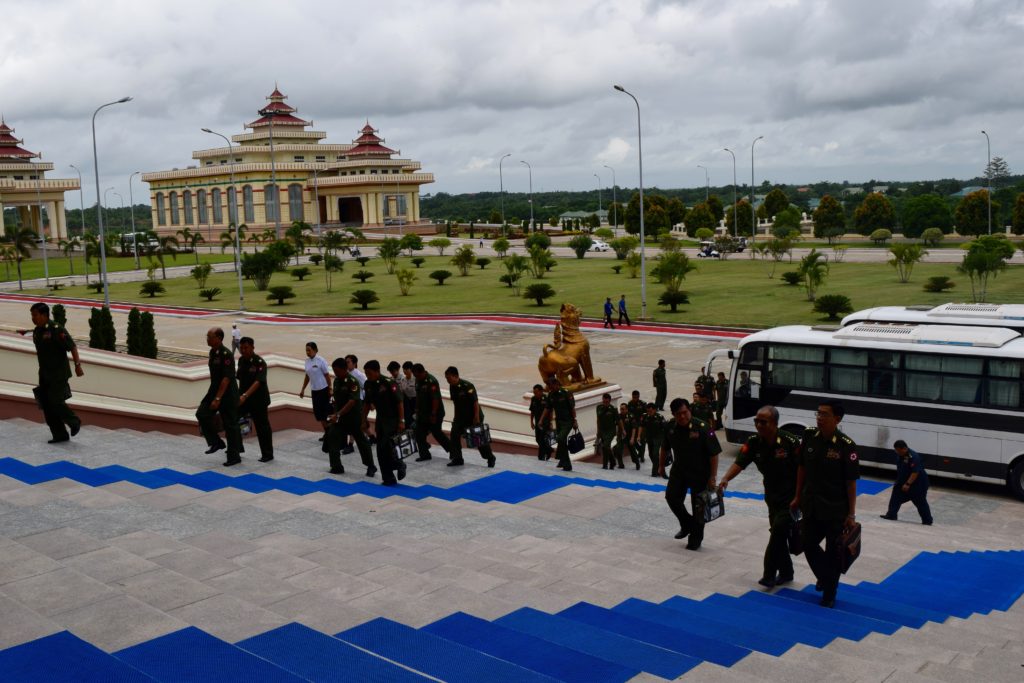
Once all of the MPs had entered the Hluttaw and taken their seat at their designated chairs in the meeting room, our guide escorted us upstairs to the visitor’s gallery. The gallery was relatively full, with men and women alike, but, unsurprisingly, we were the only foreigners. While we had been waiting, our guide had quickly translated and summarized the main points on the agenda for that morning. First the MPs would discuss improving the physical education curriculum and overall sport opportunities in schools, then debate the construction of more hospitals in rural towns, and finally address the violence towards the Rohingya in the Rakhine state. I was especially interested in hearing the discussion of the latter, as violence towards the Rohingya had escalated exponentially in the state over the last few months and the Myanmar government, both the NLD and military representatives alike, had been largely on this topic.
The meeting began with the procession of the speaker and the Heraldic, a golden gavel that, once placed on its stand at the front of the room, marks the commencement of the meeting. I was instantly shocked and amazed at how civil and well-organized everything was. MPs who were addressing a topic on the agenda were to have prepared their speeches, as well as submit any presentation materials, in advance, so as to maximize the efficiency of the meeting. All speeches were timed, and MPs respectfully sat down when their allotted time was up without making a fuss. Responses were permitted, but were timed just as precisely as the speeches. There was no heckling and no unplanned interruptions. Our guide explained that journalists are not allowed to attend the meetings, although they are permitted to wait outside and ask the MPs questions as they leave the assembly meeting room, and no guest is allowed to bring in any recording devices, as once an MP was photographed sleeping while parliament was in session and complained.
Interestingly, the military MPs did not speak once, almost as if to suggest that the meeting was merely a front and that all real decision-making took place behind closed doors, such as one of the parliament employees had insinuated. Likely as a result of this silence, there was no visible tension or display of animosity between the various political parties, despite the history of violence that existed between them. The meeting successfully covered all items on the agenda, and proposals, when relevant, were introduced and voted on. Although the meeting was in the Myanmar language, the various pictures throughout the presentations and our guide’s occasional translation, allowed us to follow what was being discussed. With regard to the Rohingya crisis, from what our guide was able to translate, there were no new developments and most of the allotted time had been spent discussing whether or not another, external investigation should be permitted, for which the majority voted no. The Myanmar government had supported a UN investigation led by former Secretary General, Kofi Annan, whose findings would be published in August, but many international figures believed that a more comprehensive explanation for the violence was needed.
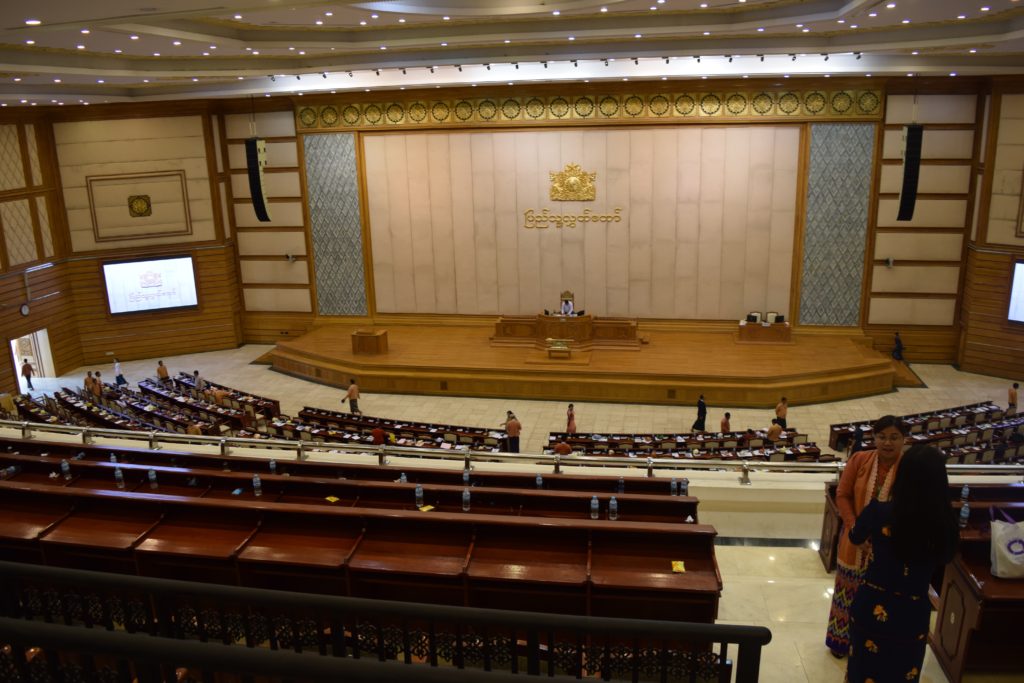
After the meeting, our guide brought us to one of the two canteens in the Hluttaw. The canteen resembled the outside of a food truck with about two dozen tables and chairs scattered around in front of it. We all ordered some food and took our seat. As I looked around I was again shocked by the civil coexistence of the different political parties; MPs from all parties sat side by side as they ate their lunches. You could hardly tell that only a few short years ago, many of these men and women had been on two very different sides of an unprecedented political and ideological divide.
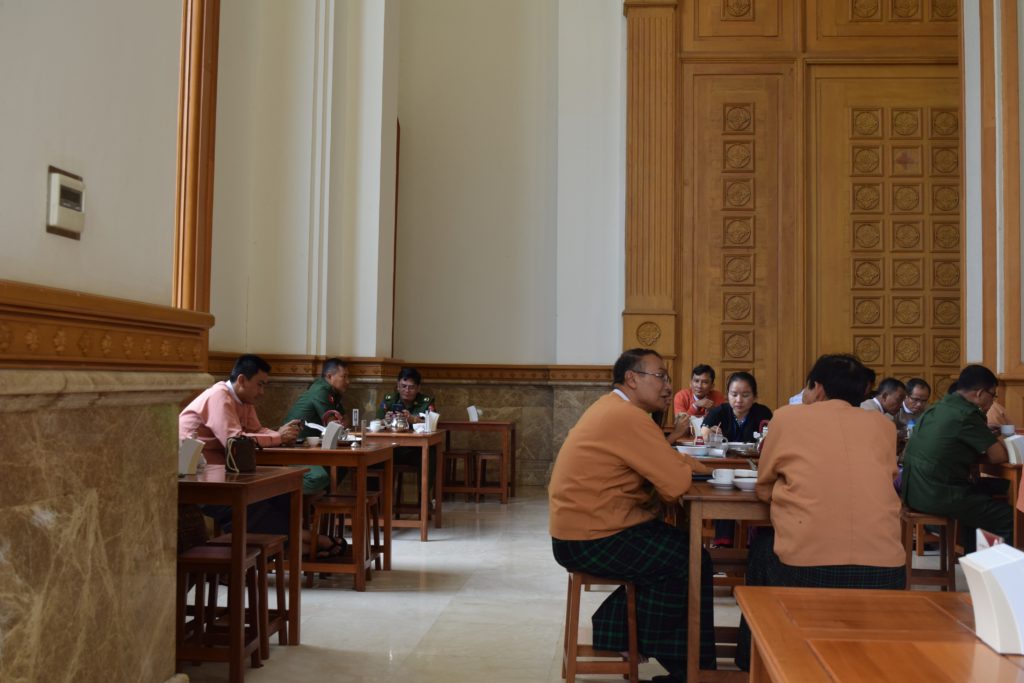
After lunch, we were given a tour of some of the other rooms in the building, including some of the conference chambers, which all house beautiful paintings of iconic Myanmar skylines and traditions. We were then brought back to our car, which was waiting for us by the exit, and driven back down the main driveway through the massive gates, leaving the strange and somewhat surreal Hluttaw behind us. Decades of turmoil and violence had been hidden away behind a meticulously crafted curtain of bureaucracy. It could either be a sign of progress, a real example of democracy in practice, or a disturbing reminder of the military’s ongoing stronghold over the country.
